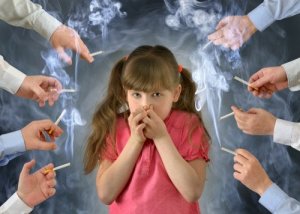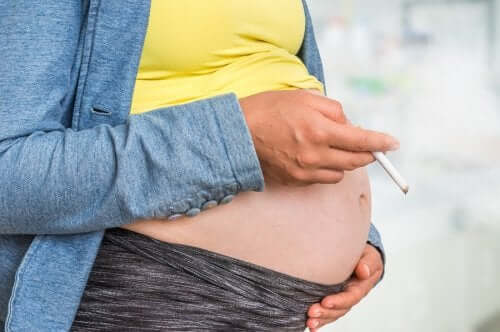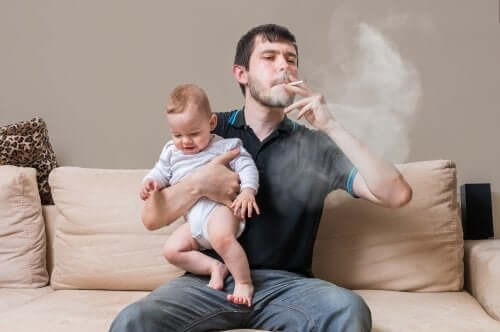Warning: The Effects of Tobacco in Children


Written and verified by the pharmacist Sara Viruega Encinas
Currently, more than 10% of children under the age of 14 are exposed to tobacco smoke daily in their homes. This is a serious problem, as children are much more vulnerable to the effects of tobacco than adults. Today we’ll take look at the effects of tobacco in children.
Tobacco during pregnancy
Consuming tobacco is very dangerous during pregnancy. A mother’s exposure to second-hand smoke while pregnant is also dangerous, but not as much as direct consumption. Smoking reduces a woman’s fertility and increases her risks of having a miscarriage.
At the same time, studies have shown that consuming tobacco during pregnancy can have serious consequences in newborns. These include low birth weight, premature birth, increased chances of malformations, risks of sudden infant death syndrome, etc. Without a doubt, smoking while pregnant is an unnecessary and avoidable risk for unborn babies.
Women who smoke should cease to do so as soon as they become pregnant, or as soon as possible. Specialists recommend that fathers also give up smoking. Doing so helps keep the environment free of smoke and helps the mother from falling back into the habit.
In the case of breastfeeding mothers, it’s important to point out that tobacco can also pass through breast milk. This exposes nursing babies to the toxic effects of this substance.

The effects of tobacco on children
Second-hand smoke is the exposure to tobacco smoke by nonsmokers. Smokey environments cause us to continuously inhale toxic substances that tobacco smoke releases in the air. These toxins are extremely damaging to our health.
In children, second-hand smoking is strongly related to an increase in respiratory illnesses like asthma and pneumonia. It also leads to an increase in the occurrence of ear infections.
Specifically, we can say that second-hand smoke can lead to:
- Acute respiratory illnesses. Tobacco smoke can cause up to 30% more infections like pneumonia, bronchitis, and bronchiolitis.
- An increase in respiratory symptoms, like sore throat, ear pain, couching, etc. The exposure to tobacco smoke irritates the mucous membrane. It can cause discomfort in the eyes and nose as well.
- Asthma and the worsening of the symptoms of asthma. Tobacco smoke increases the frequency of asthma attacks by up to 20%.
- A greater chance of suffering from lung cancer.
- A greater risk of suffering heart problems.
Children are especially vulnerable to tobacco smoke because their bodies aren’t yet completely mature and developed. This means they’re unable to combat the damage caused by tobacco’s toxic agents the same way adults can.
Furthermore, the number of breaths they take per minute is higher than that of adults – meaning they inhale more smoke.
How to keep children from becoming smokers?
The risk of children picking up the habit of smoking in the future is higher when their parents are smokers. When children grow up in a home where they witness tobacco abuse, then they have a higher chance of becoming active smokers.
In fact, the age at which children begin smoking is becoming younger and younger. In these cases, the effects of tobacco are much more serious than in adults:
- It can produce delays in growth as well as in development.
- Increased risk of suffering from diabetes and obesity.
- A predisposition to behavior alterations, such as hyperactivity and attention deficit.

Some studies claim that adolescents who smoke are more likely to consume alcohol and other drugs. They’re more likely to incur in risky sexual behavior as well.
It’s also important to point out that the earlier a person begins to smoke, the greater the risks are to their health. At the same time, picking up smoking at an earlier age makes it harder to break the habit.
Conclusions regarding the effects of tobacco on children
According to the World Health Organization, tobacco is the main cause of illness, invalidity and preventable death in the world. It’s not only damaging for our health but for that of our children as well. Children are especially vulnerable to its harmful substances.
Therefore, we should avoid tobacco in our homes and stay away from areas that are full of smoke and toxins. Today we have access to many tools that can help you quit smoking. You too can do it!
Currently, more than 10% of children under the age of 14 are exposed to tobacco smoke daily in their homes. This is a serious problem, as children are much more vulnerable to the effects of tobacco than adults. Today we’ll take look at the effects of tobacco in children.
Tobacco during pregnancy
Consuming tobacco is very dangerous during pregnancy. A mother’s exposure to second-hand smoke while pregnant is also dangerous, but not as much as direct consumption. Smoking reduces a woman’s fertility and increases her risks of having a miscarriage.
At the same time, studies have shown that consuming tobacco during pregnancy can have serious consequences in newborns. These include low birth weight, premature birth, increased chances of malformations, risks of sudden infant death syndrome, etc. Without a doubt, smoking while pregnant is an unnecessary and avoidable risk for unborn babies.
Women who smoke should cease to do so as soon as they become pregnant, or as soon as possible. Specialists recommend that fathers also give up smoking. Doing so helps keep the environment free of smoke and helps the mother from falling back into the habit.
In the case of breastfeeding mothers, it’s important to point out that tobacco can also pass through breast milk. This exposes nursing babies to the toxic effects of this substance.

The effects of tobacco on children
Second-hand smoke is the exposure to tobacco smoke by nonsmokers. Smokey environments cause us to continuously inhale toxic substances that tobacco smoke releases in the air. These toxins are extremely damaging to our health.
In children, second-hand smoking is strongly related to an increase in respiratory illnesses like asthma and pneumonia. It also leads to an increase in the occurrence of ear infections.
Specifically, we can say that second-hand smoke can lead to:
- Acute respiratory illnesses. Tobacco smoke can cause up to 30% more infections like pneumonia, bronchitis, and bronchiolitis.
- An increase in respiratory symptoms, like sore throat, ear pain, couching, etc. The exposure to tobacco smoke irritates the mucous membrane. It can cause discomfort in the eyes and nose as well.
- Asthma and the worsening of the symptoms of asthma. Tobacco smoke increases the frequency of asthma attacks by up to 20%.
- A greater chance of suffering from lung cancer.
- A greater risk of suffering heart problems.
Children are especially vulnerable to tobacco smoke because their bodies aren’t yet completely mature and developed. This means they’re unable to combat the damage caused by tobacco’s toxic agents the same way adults can.
Furthermore, the number of breaths they take per minute is higher than that of adults – meaning they inhale more smoke.
How to keep children from becoming smokers?
The risk of children picking up the habit of smoking in the future is higher when their parents are smokers. When children grow up in a home where they witness tobacco abuse, then they have a higher chance of becoming active smokers.
In fact, the age at which children begin smoking is becoming younger and younger. In these cases, the effects of tobacco are much more serious than in adults:
- It can produce delays in growth as well as in development.
- Increased risk of suffering from diabetes and obesity.
- A predisposition to behavior alterations, such as hyperactivity and attention deficit.

Some studies claim that adolescents who smoke are more likely to consume alcohol and other drugs. They’re more likely to incur in risky sexual behavior as well.
It’s also important to point out that the earlier a person begins to smoke, the greater the risks are to their health. At the same time, picking up smoking at an earlier age makes it harder to break the habit.
Conclusions regarding the effects of tobacco on children
According to the World Health Organization, tobacco is the main cause of illness, invalidity and preventable death in the world. It’s not only damaging for our health but for that of our children as well. Children are especially vulnerable to its harmful substances.
Therefore, we should avoid tobacco in our homes and stay away from areas that are full of smoke and toxins. Today we have access to many tools that can help you quit smoking. You too can do it!
All cited sources were thoroughly reviewed by our team to ensure their quality, reliability, currency, and validity. The bibliography of this article was considered reliable and of academic or scientific accuracy.
- Flores, A., Iglesias, V., & Oyarzún, M. (2011). Exposición a humo de tabaco ambiental: efectos sobre la salud respiratoria infantil. Neumol pediátr, 6, 16-21.
- Bertrand, P. (2011). Efectos clínicos de la exposición directa e indirecta a tabaco en los niños. Neumología Pediatrica, 8.
- Sánchez-Zamorano, L. M., Téllez-Rojo, M. M., & Hernández-Avila, M. (2004). Efecto del tabaquismo durante el embarazo sobre la antropometría al nacimiento. salud pública de méxico, 46, 529-533.
This text is provided for informational purposes only and does not replace consultation with a professional. If in doubt, consult your specialist.








